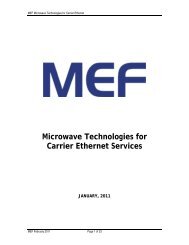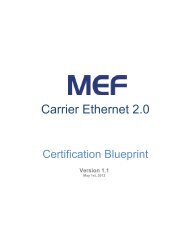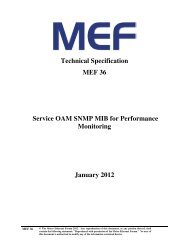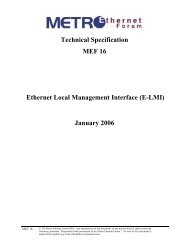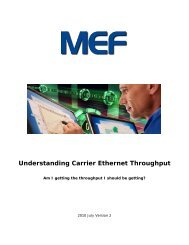User Network Interface (UNI) Requirements and Framework - MEF
User Network Interface (UNI) Requirements and Framework - MEF
User Network Interface (UNI) Requirements and Framework - MEF
You also want an ePaper? Increase the reach of your titles
YUMPU automatically turns print PDFs into web optimized ePapers that Google loves.
<strong>UNI</strong> <strong>Requirements</strong> <strong>and</strong> <strong>Framework</strong><br />
CE A<br />
<strong>UNI</strong>-C A<br />
Management plane<br />
YHP tenrehtE sNART<br />
sNART<br />
kniL dexelpitluM<br />
<strong>UNI</strong>-N A<br />
Management plane<br />
dexelpitluM sNART<br />
kniL<br />
TRANsLink<br />
Data plane Control plane<br />
<strong>UNI</strong>-C B<br />
Management plane<br />
TRANs Link<br />
ETH Access Link<br />
ETH Access Link<br />
ETH Access Link<br />
ETH Acess Link<br />
TMF<br />
ETH Access Link ETH Acess Link<br />
Control plane<br />
Data plane<br />
MEN FE<br />
<strong>UNI</strong>-N B<br />
Management plane<br />
ETH Trunk Link<br />
ETH Trunk Link<br />
Data plane<br />
Control plane<br />
Control plane<br />
Data plane<br />
ECF<br />
ETH Trunk Link<br />
CE B<br />
tenrehtE<br />
lautriV<br />
noitcennoC<br />
Figure 7: Relationship between <strong>UNI</strong> Reference Functional Model <strong>and</strong> MEN <strong>Network</strong><br />
Reference Model – Attachment via TMF<br />
7. <strong>UNI</strong> Types<br />
This document introduces 3 types of <strong>UNI</strong>s: <strong>UNI</strong> Type 1, <strong>UNI</strong> Type 2, <strong>and</strong> <strong>UNI</strong> Type 3. These<br />
three types of <strong>UNI</strong>s determine the CE’s ability to negotiate services connections <strong>and</strong> attributes.<br />
The following section describes the operational aspects of three types:<br />
7.1 <strong>UNI</strong> TYPE 1<br />
The <strong>MEF</strong> <strong>UNI</strong> Type 1 will operate in manual configuration operation in which the Service<br />
Provider <strong>and</strong> Subscriber will have to manually configure the <strong>UNI</strong>-N <strong>and</strong> <strong>UNI</strong>-C for services.<br />
7.2 <strong>UNI</strong> TYPE 2<br />
The <strong>UNI</strong> TYPE 2 mode of operation allows the <strong>UNI</strong>-N to provision, configure, <strong>and</strong> distribute<br />
EVC information <strong>and</strong> the associated service attributes to the CE. In a manner akin to Frame<br />
Relay LMI <strong>and</strong> ATM ILMI, the CE in <strong>UNI</strong> Type 2 mode can retrieve certain information from<br />
the network through an automated link management interface. The customer equipment (CE) is<br />
<strong>MEF</strong> 11<br />
© The Metro Ethernet Forum 2005. Any reproduction of this document, or any portion thereof, shall<br />
contain the following statement: "Reproduced with permission of the Metro Ethernet Forum." No user<br />
of this document is authorized to modify any of the information contained herein.<br />
Page 15




